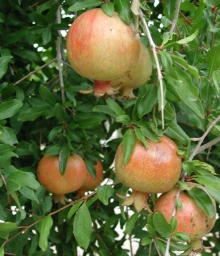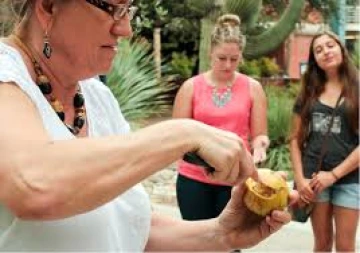
Pomegranate Harvest History
UA LEAF conducted its very first pomegranate harvest in August 2014 with freshmen students from UA's Bear Down Camp and Iskashitaa Refugee Network. Students had the opportunity to experience the sweet taste of freshly picked pomegranate fruit on a hot summer day. Below is a story written by LEAF Intern Haley Anderson about the harvest.
Freshmen and refugees harvest pomegranates on UA Campus
By Haley Anderson

Barbara Eiswerth, director of the Iskashitaa Refugee Network, opened a pomegranate “Mexican” style and passed it around for tasting to a diverse group of freshmen and refugees gathered on campus the Thursday before the start of the fall semester. This pomegranate variety was a seedless blonde that had just been pulled off the trees growing north of the University of Arizona student union. Incoming freshmen in the U of A’s Bear Down Camp were volunteering in the pomegranate harvest as a part of their freshmen day of service.
They looked tentative about tasting the pomegranate, which was unusually light in color, but they found it sweet, and soft enough to chew through the entire seed. The freshmen participated in the harvest alongside refugees from Iskashitaa Refugee Network and interns for UA LEAF (Linking Edible Arizona Forests). "It's hot and muggy out but it's not too bad," said freshman Lukas Niennuis, a mechanical engineering major. "Even though this doesn't relate to my major I still like doing these things for fun."
UA LEAF, supported by the UA Green Fund, is affiliated with the statewide LEAF program. They work to harvest some of the 1,800 trees, tracked by UA’s Campus Arboretum, producing edibles on campus. LEAF’s goal is to link people with the benefits of edible trees, and edible trees with the care of people
/student-projects/leaf-linking-edible-arizona. Eiswerth, also a UA LEAF leader, said the Iskashitaa Refugee Network works with the community to harvest food, promote sustainability and educate about U.N. refugees while “gleaning” food that might have gone to waste. “We are using food as an entry point to the community and to welcome United Nation refugees and asylum seekers fleeing from violence,” said Eiswerth, who is also an adjunct professor in the UA School of Natural Resources and the Environment.
The harvested fruit will predominately go to the refugees and their families that Eiswerth said sometimes haven’t had a particular fruit or vegetable in years. At the same time, Iskashitaa aims to integrate refugees into American society through the harvests. The refugees learn about American culture, learn English, and form relationships while collecting food from local trees and farms. Simultaneous to all the learning, refugees teach Tucsonans their culinary wisdom about unfamiliar foods such as purslane, jujubes, and Seville oranges.
Refugees from Bhutan, Sudan, and Burundi participated in the harvest and noted that pomegranate is a favored fruit in their homeland. Some of the refugees have been in the United States for seven years, while another had arrived in America only eight days earlier. Upon arrival, most are surprised to see fruit rotting on the ground rather than harvested.
Sabir Adam is a refugee from Darfur, Sudan who participated in the harvest. He has been in America for three years now and said that he considers the people of Iskashitaa family. “I like volunteering when I am not working. I’m good and fast at it,” he said about harvesting. Adam and the other refugees were eager and quick to harvest the pomegranates while many of the freshman were more hesitant. The majority had never harvested anything before and initially struggled to collect the fruit. “It’s all in the wrist action!” Eiswerth instructed. It took only seconds for her to remove a fruit by swiftly swinging her wrist and grasping it mid-swing. Iskashitaa and UA LEAF started working together last year to harvest fruit on campus, including olives, Calamondin limes and Seville oranges. They started this year off early with the pomegranate harvest and plan to continue with other fruits throughout the year.
These projects can build a larger support system by introducing them early on to new students. The opportunity to introduce freshmen to sustainable living and eating locally can only further the goals of LEAF and Iskashitaa and benefit the community, UA LEAF Project Manager Melanie Lenart said.
“It’s really cool to see different walks of life come together like this,” said Freshman Daniel Moore, a Computer Science major. “You can tell it’s a good group of people trying their best to make a difference.”
For more information on upcoming harvests, check out the UA LEAF Facebook page. https://www.facebook.com/UALEAF

